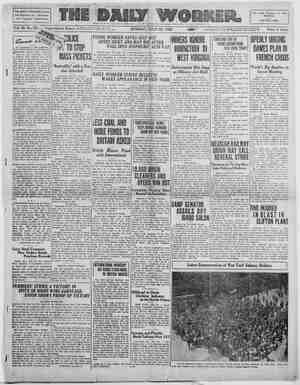Evening Star Newspaper, July 25, 1926, Page 90
You have reached the hourly page view limit. Unlock higher limit to our entire archive!
Subscribers enjoy higher page view limit, downloads, and exclusive features.
THE SUNDAY STAR, WASHINGTON. D. €, Mummy of the young King as first discovered. Covering the head is a gold mask, and the triple necklace is of yellow, red and gold faience beads. The gold hands are separate, and they hold the emblems of office. Pectoral from the exterior wrappings of the mummy of King Tut. It takes the form of a Ba-Bird, and is of finely chased gold on its under surface, with turquoise, carnelian and lapis lazuli on the upper surface. The sarcophagus, with the second coffin above, where King Tut-ankh-Amen vc.rill now rest forever, in the tomb at Thebes. - King Tut-ankh-Amen'’s perfume box, between 6 and 7 inches in height, of geld with a silver pedestal. The figures of the King, elaborately chased, hold the emblems of office. The box once held sacred oils. = GRAVURE SECTION-—-JULY Head and Crown of King Tut-ankh-Amen Revealed With Latest Discoveries All photos © by Harry Burton, Metropolitan Museum of Art, from Wide World Photox The mummified head of the young King Tut-ankh-Amen. According to the discoverers the head “shows a serene and placid countenance, the face being refined and cultured, the features well formed and the lips clearly marked.” The ear is pierced for a ring, but no trace of the ornament was found. One of the two magnificent daggers found The triple necklace of King Tut. It was among the treasures of the coffin. The blade is attached to the neck of the mask by means of of hardened gold, and the handle is orna- cobra-shaped clasps, and is made of red, yel- mented with gold and bands of precious low and gold faience. 3 stones. King Tut’s gold diadem, found on the head of the mummy. It is of the simple fillet type, surmounted by the royal insignia. This is the first Pharaonic diadem ever discovered, and the stones are lapis lazuli, car- nelian and turquoise, set in pure gold. The band has adjustable fastenings. Sheath of one of the elaborate dag- gers, decorated with wild animals. It is Aegean in character, but the handi- craft is Egyptian, the other side of the sheath containing a feather design. 20, 1926 The gold eoffin when first discovered. Around the neck is a floral collarette composed of real flowers sewn upon a papyrus backing. Among the flowers are blue faience beads. “ “Collar of Nekhebet,” which was among the massive treas- ures found within the wrappings of the mummy. It is flexible and composed of 225 separate gold plaques finely interlaid in cloisonne fashion. The collar was. attached to King Tut’s neck with a fine gold wire. Bas-relief of Thothmes III, one of the newest discoveries of Howard Carter in the tomb of King Tut. The bas-relief por- trays the King who lived 100 years before King Tut, and he wears a diadem similar to the one found on the head of King Tut. Vulture's head from the insignia of the diadem of King Tut. It is made of gold, the eyes of obsidian.

